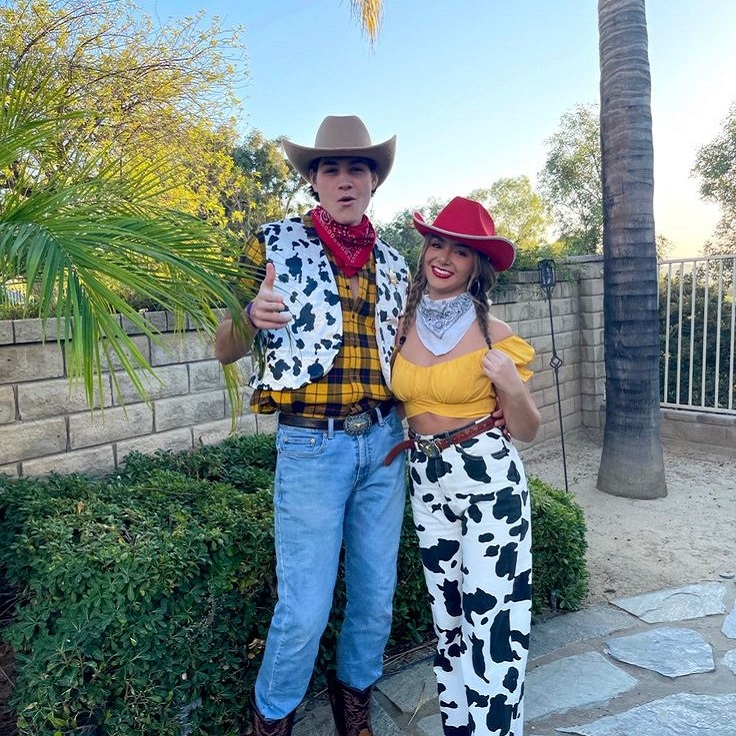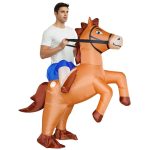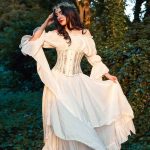Origins of Halloween Costumes
What was the first Halloween costume? Tracing the history of Halloween costumes takes us far back in time. The tradition of wearing costumes is deeply rooted in ancient rituals and seasonal celebrations.

Ancient Celtic Festival of Samhain
The Celtic festival of Samhain marks the origins of Halloween costumes. Over 2,000 years ago, the Celts celebrated Samhain on October 31. This day marked the end of harvest and the beginning of the colder months. The Celts believed that on this night, the boundary between the living world and the afterlife blurred. To protect themselves from wandering spirits, they donned costumes made of animal skins. This practice was meant to confuse the spirits, making them think that the living were spirits too.
Early Christian Influence and All Hallows’ Eve
As Christianity spread, it assimilated many pagan practices, including Samhain. The Christian church designated November 1st as All Saints’ Day, a time to honor saints and martyrs. The night before, known as All Hallows’ Eve, continued the tradition of wearing costumes. However, these costumes began to symbolize Christian figures like saints and angels. This blend of pagan and Christian traditions helped shape the Halloween celebrations we recognize today.
Transition in America: 18th and 19th Centuries
When Halloween reached America, changes began. The holiday mixed with other cultures and adapted.
Early American Costume Traditions
In the 18th century, Irish and Scottish immigrants brought Halloween to America. They shared their Samhain customs. People in America dressed up to blend in with spirits, just like in Celtic times. These early costumes were simple and often scary to match the night’s eerie feeling.
Rise of Home-made and Improvised Costumes
By the 19th century, Americans made costumes from what they had. They used sheets, old clothes, and natural materials. Communities started to celebrate together. They used costumes to entertain and tell fortunes. Making costumes became a way to show skill and creativity. This era set the foundation for how Americans would celebrate Halloween for years to come.
20th Century Transformations
The 20th century brought significant changes to Halloween costumes. The period witnessed innovations in costume design and the rise of mass-produced options.
The Emergence of Mass-produced Costumes
In the initial decades of the 20th century, homemade costumes dominated. Progressing through the century, advancements in manufacturing allowed the mass production of costumes. Companies like the J. Halpern Company, known as Halco, began producing licensed images of popular characters. This shift made costumes widely accessible and began the transition from custom, handmade creations to store-bought costumes. This era marked a significant transformation in how costumes were viewed and consumed by the public.
Pop Culture and Costume Evolution
The evolution of Halloween costumes has been significantly shaped by the rise of popular culture, particularly through the mediums of television, movies, and comic books. By the mid-20th century, these forms of media had become powerful influencers, transforming the way people approached their Halloween attire. The impact was profound, as characters from beloved TV shows, blockbuster films, and iconic comic books began to dominate the costume landscape.
This shift in costume trends was not just a matter of preference; it reflected a broader cultural change. Traditional spooky outfits, such as witches, ghosts, and goblins, which had long been the norm, were gradually replaced by a more diverse and character-driven array of choices. People were no longer content with generic, off-the-shelf costumes; instead, they sought to embody their favorite characters, bringing a new level of creativity and personalization to their Halloween ensembles.
For example, fans of classic TV shows like “I Love Lucy” or “The Addams Family” might dress up as Lucy Ricardo or Morticia Addams, while movie enthusiasts could choose to emulate the likes of James Bond or Marilyn Monroe. Comic book fans, on the other hand, found inspiration in superheroes like Superman, Batman, and Wonder Woman, as well as in the colorful and often complex villains that populated their stories. This trend allowed for a wide range of expressions, from the heroic to the whimsical, and from the glamorous to the outright bizarre.
Adults with Halloween
Perhaps one of the most significant changes during this period was the re-engagement of adults with Halloween. No longer seen as a holiday solely for children, Halloween became an opportunity for grown-ups to participate in themed parties and events. These gatherings provided a platform for adults to showcase their creativity and to draw inspiration from a broad range of contemporary media and entertainment sources. From 1950s sock hops to futuristic sci-fi themes, the possibilities were endless, and the costumes reflected a rich tapestry of cultural influences.
This rekindled interest in Halloween among adults also led to a boom in the costume industry. Specialty stores and online retailers began to offer a wider variety of high-quality, detailed costumes, catering to the growing demand for more authentic and elaborate outfits. DIY costume-making also saw a resurgence, with people using their skills and imagination to create unique and personalized looks.
In summary, the influence of pop culture on Halloween costumes by the mid-20th century marked a significant turning point. It not only expanded the range of available options but also transformed the holiday into a more inclusive and creative celebration, where both children and adults could express themselves through the characters and stories that resonated with them. This evolution continues to this day, with each new generation finding new and innovative ways to celebrate Halloween, drawing inspiration from the ever-evolving world of popular culture.

The Commercialization of Halloween
The celebration of Halloween evolved greatly over time, and with it, the business of costumes flourished. By the early 20th century, what began as home-crafted disguises turned into a booming market. The rise of costume companies showcased a new era in Halloween tradition – one where convenience often trumped creativity.
Rise of Costume Companies and Licensing
With the advent of licensing agreements, well-known brands and characters entered the Halloween scene. Companies like Halco started producing costumes featuring famous icons like Popeye and Mickey Mouse. This led to a surge in children and adults alike opting for pre-made costumes that celebrated contemporary idols.
The licensing of images meant a move towards a more commercialized Halloween. It signaled a shift in consumer behavior, where the majority now preferred to purchase a ready-made costume rather than constructing one from scratch.
Shift from Handmade to Store-bought Costumes
As costume companies grew, the availability and variety of store-bought costumes increased. Handmade costumes, once a staple of Halloween creativity, were pushed aside for the convenience of pre-packaged outfits. Families started to choose from a range of pre-made options, lessening the need for crafting skills or time investments.
This shift was not just about convenience—it also reflected a wider cultural change. It cemented Halloween as a marketable holiday, with costumes turning into must-have items for annual festivities. The reliance on store-bought costumes also pointed to a society more focused on consumerism and less on the communal crafting traditions of the past.
Societal Impacts and Changes
Changes in Costume Trends Over Decades
Halloween costumes have transformed through the decades. Early 1900s’ dark themes gave way to pop culture influences by the 1960s. Television shows, movies, and comic books started to shape costume choices. By the 1960s, adults also embraced Halloween, showcasing diverse inspirations at themed events. Today, also reflecting environmental concerns, some shift back to handmade outfits is seen.
Over time, people preferred humor and convenience in their costume choices. Costumes became extensions of personalities, with many opting to be superheroes or celebrities. The ’70s and ’80s brought horror movie-inspired costumes adding fright to the fun. Presently, trends show a mix of classic spooky outfits, current event characters, and a boom in ‘sexy’ and ‘fantasy’ costumes.
The Role of Media and Popular Culture
The media has a strong role in shaping Halloween costumes. Every year, tv shows, movies, and celebrity trends spark new costume ideas. The late 20th century saw iconic characters from ‘Star Wars’ and ‘Indiana Jones’ become favorites. Superhero films now fuel many costume designs.
Popular culture pushes what’s in style. Social media trends also guide costume popularity today. People use platforms like Instagram for inspiration or to showcase their get-ups. This has led to a rapid exchange of ideas, making some costumes go viral.
The internet’s influence is undeniable. Many hunt for trending costumes online to stay current. Some also seek unique DIY ideas to stand out. As the holiday evolves, media will remain a driving force in costume innovation.

Modern Trends and Criticisms
As Halloween has evolved, so have the trends and public perceptions regarding costumes. This section explores the environmental impact of costume waste and the shift towards more revealing and fantasy-based costumes.
Environmental Impact of Costume Waste
The trend of buying new costumes each year contributes significantly to environmental waste. Many costumes, made from non-biodegradable materials, end up in landfills after a single use. This raises concerns about excessive waste and the environmental footprint of Halloween celebrations. Efforts to reduce this impact include promoting costume swaps, encouraging the use of eco-friendly materials, and advocating for costumes that can be reused.
Shift Toward More Revealing and Fantasy-Based Costumes
Over the years, Halloween costumes have shifted from traditional spooky themes to include more revealing and fantasy-based outfits. This change reflects broader cultural shifts towards individual expression and the influence of media. While some enjoy the creativity and escapism these costumes offer, others critique this trend for potentially objectifying wearers. This shift also highlights the role of media and popular culture in shaping public perceptions and costume choices.


